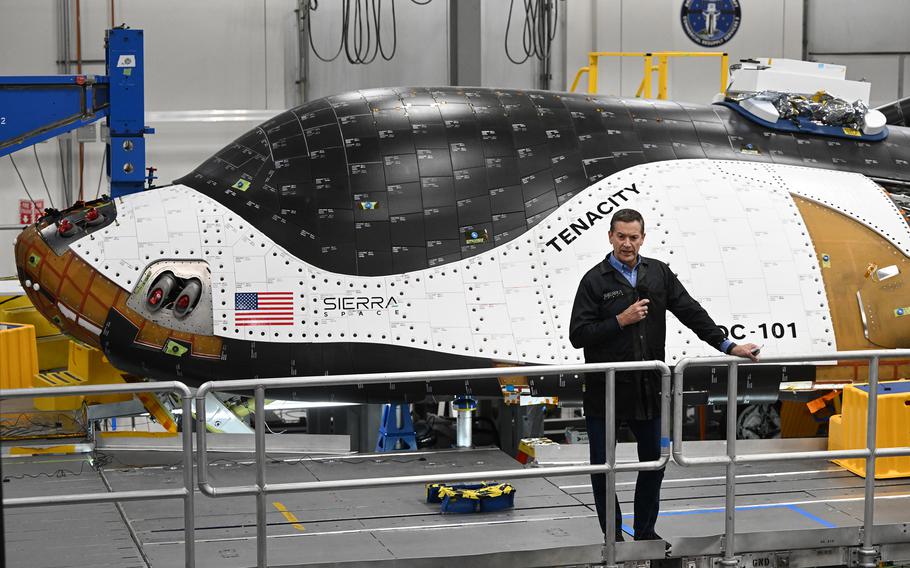
Tom Vice, CEO of Sierra Space, talks to hundreds of employees in front of the Dream Chaser to thank them for their work at Sierra Space on Oct. 30, 2023, in Louisville, Colo. (Helen H. Richardson, The Denver Post/TNS)
(Tribune News Service) — The Sierra Space Dream Chaser looks like a mini space shuttle, and it’s gearing up for its first trip to space atop United Launch Alliance’s new Vulcan Centaur rocket in 2024.
The uncrewed spacecraft is designed for now to take cargo to the International Space Station, having won a NASA contract to join SpaceX and Northrop Grumman for commercial resupply missions.
The first nearly complete version of Dream Chaser is named Tenacity, and is set to leave Sierra Space’s Louisville, Colorado, production facility to begin its journey to the Space Coast. Its first stop, though, will be to NASA’s Neil Armstrong Test Facility in Sandusky, Ohio, for a battery of environmental shakedown tests in the coming weeks.
“Today we have arrived at a profound milestone in both our company’s journey and our industry’s future – one that has been years in the making and is shaped by audacious dreaming and tenacious doing,” said Sierra Space CEO Tom Vice during an event heralding the completion of what is planned to be a fleet of Dream Chasers.
Just like the space shuttle, it will launch from Florida and land in Florida. It’s slated to be the Certification-2 mission for United Launch Alliance’s Vulcan Centaur, which is gearing up for Certification-1, a mission to send the Astrobotic Peregrine lunar lander to the moon, as early as Dec. 24.
Vulcan Centaur, which will launch from Cape Canaveral Space Force Station’s Space Launch Complex 41, is the replacement rocket for ULA’s Atlas V and Delta IV family of rockets, powered by two American-made engines by Blue Origin. ULA needs both missions under its belt before it can begin a spate of missions it has lined up for the Department of Defense.
ULA President and CEO Tory Bruno this past summer said it would try to fly Dream Chaser within the first few months of 2024 if its first Vulcan flight goes well. Tenacity, though, still has several months of testing in Ohio before making its way to the Space Coast.
The spacecraft will go through hot and cold extremes under a simulated vacuum to ensure vehicle performance in space and Vice last week targeted April as the earliest possible launch, which also requires NASA to find an open parking space at the busy space station.
Dream Chaser, which has been in the works for 15 years, would become a unique option for NASA, with the ability to make a landing right back at the former space shuttle landing facility at Kennedy Space Center. SpaceX Cargo Dragon spacecraft make water landings off the Florida coast while Northrop Grumman’s Cygnus cargo capsules burn up in Earth’s atmosphere once NASA is done with them.
The trip up actually features Dream Chaser connected to an expendable cargo module called Shooting Star so it can cart up about 12,000 pounds of cargo, although return trips can only handle about 4,000 pounds. NASA can use the Shooting Star, though, to get rid of trash as it, just like Cygnus, burns up in the atmosphere.
The mission plan calls for ISS crew to capture Dream Chaser by grappling the Shooting Star module with the Canadian robotic arm at the station and marry it to one of the ISS ports.
Sierra Space has seven cargo missions to fly to and from the ISS under NASA’s Commercial Resupply Services 2 (CRS-2) contract awarded in 2016. The return trips also feature low G-force landings — less than 1.5 G’s — something that allows for more delicate science including live animals to return safely from space within the pressurized cargo hold. It’s built to withstand 3,000 degrees Fahrenheit on reentry and make at least 15 trips to space each. Work on a second Dream Chaser has already begun.
Sierra Space also has plans to expand Dream Chaser to support crew, and the spacecraft is central to its efforts to support its partnership with Blue Origin to develop a commercial low-Earth-orbit space station called Orbital Reef. Although a finalist, that version of the Dream Chaser lost out to SpaceX’s Crew Dragon and Boeing’s CST-100 Starliner in 2014 when NASA chose those two companies for rotational crew duties to the ISS.
Dream Chaser is about 1/4th the size of space shuttle orbiters, and would support up to seven crew members and supplies. It also can land at any compatible commercial runway, not just the one at KSC.
In 2022, though, Sierra Space said it would base its commercial astronaut training at KSC, and company officials still are targeting 2026 for a passenger-ready version of the Dream Chaser.
©2023 Orlando Sentinel.
Visit at orlandosentinel.com.
Distributed by Tribune Content Agency, LLC.